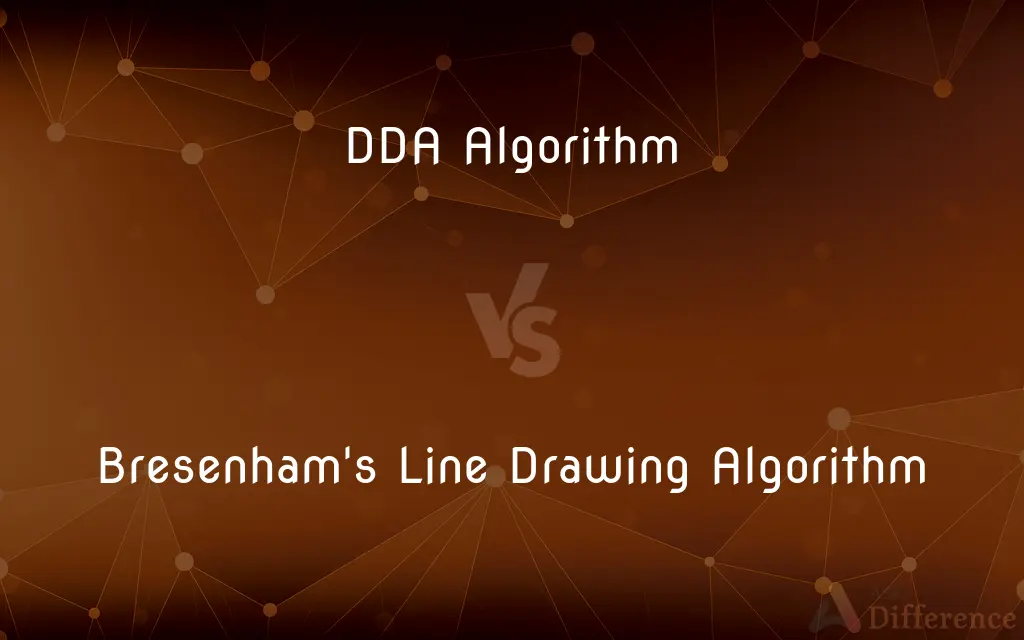DDA Algorithm vs. Bresenham's Line Drawing Algorithm — What's the Difference?
By Tayyaba Rehman — Published on January 13, 2024
DDA (Digital Differential Analyzer) Algorithm is a simple line drawing method using floating point arithmetic. Bresenham's Algorithm draws lines using integer arithmetic, making it faster and more efficient.

Difference Between DDA Algorithm and Bresenham's Line Drawing Algorithm
Table of Contents
ADVERTISEMENT
Key Differences
DDA Algorithm is used for rasterization of lines, triangles, and polygons in computer graphics. It incrementally calculates the values of points at regular intervals on a line. This process involves floating-point arithmetic, which can be computationally expensive. In contrast, Bresenham's Line Drawing Algorithm is more efficient as it uses integer arithmetic, avoiding the need for floating-point calculations.
DDA Algorithm is simpler to understand and implement but can be slower due to its use of floating-point operations. It also may produce rounding errors, affecting the visual quality of the line. However, Bresenham's Algorithm is more accurate and efficient, especially for steep lines, as it determines the closest pixel to the theoretical line at each step without floating-point calculations.
In terms of performance, DDA Algorithm is less efficient, making it less suitable for high-performance graphics rendering where speed is critical. On the other hand, Bresenham's Algorithm is known for its high performance and is widely used in graphics libraries and systems for its speed and accuracy.
The DDA Algorithm can lead to gaps in the line for steep slopes due to rounding errors, while Bresenham's Algorithm ensures continuous lines without gaps. Bresenham's approach is better suited for applications where line continuity and smoothness are important.
When it comes to versatility, DDA Algorithm is more general and can be used for drawing curves and circles with modifications. Conversely, Bresenham's Algorithm is primarily optimized for drawing straight lines and is not as directly adaptable for other shapes.
ADVERTISEMENT
Comparison Chart
Arithmetic Used
Floating-point arithmetic
Integer arithmetic
Complexity and Ease of Use
Simpler, easier to understand and implement
Slightly more complex but more efficient
Performance
Slower due to floating-point calculations
Faster and more efficient
Accuracy and Visual Quality
May produce rounding errors, affecting line quality
More accurate, produces continuous and smooth lines
Adaptability for Other Shapes
More adaptable for curves and circles
Primarily optimized for straight lines
Compare with Definitions
DDA Algorithm
DDA Algorithm is a line rasterization method.
We used the DDA Algorithm for basic line drawing in our graphics project.
Bresenham's Line Drawing Algorithm
Avoids floating-point calculations.
Bresenham's Algorithm speeds up rendering by using integers.
DDA Algorithm
Involves floating-point arithmetic to plot points.
DDA calculates each point's coordinates with floating-point numbers.
Bresenham's Line Drawing Algorithm
Bresenham's Algorithm uses integer arithmetic for line drawing.
Bresenham's Algorithm was perfect for fast line rendering in our game.
DDA Algorithm
Simpler to implement but less efficient.
DDA was easy for our beginners' graphics class.
Bresenham's Line Drawing Algorithm
Best suited for high-performance graphics.
For our high-resolution graphics, Bresenham's Algorithm was the best choice.
DDA Algorithm
Prone to rounding errors in steep lines.
In our DDA implementation, we noticed errors in steep lines.
Bresenham's Line Drawing Algorithm
Ensures continuous and gap-free lines.
Lines drawn with Bresenham's Algorithm are smooth and continuous.
DDA Algorithm
Useful for educational purposes in computer graphics.
DDA is often taught first in computer graphics courses.
Bresenham's Line Drawing Algorithm
More efficient and accurate than DDA.
We switched to Bresenham's Algorithm for its precision.
Common Curiosities
Can the DDA Algorithm be used for drawing circles?
Yes, with modifications, DDA can be adapted for drawing circles and curves.
What is Bresenham's Line Drawing Algorithm?
It's an algorithm for drawing lines using integer arithmetic, known for its efficiency and accuracy.
Why is floating-point arithmetic a disadvantage for line drawing algorithms?
It's slower and can lead to rounding errors, affecting line quality.
Can Bresenham's Algorithm be used for rasterizing polygons?
Primarily it's for lines, but with modifications, it can be used for polygons.
Does the DDA Algorithm require more computational power?
Yes, due to its use of floating-point arithmetic.
When should I use the DDA Algorithm?
Use DDA for simple graphics applications where high performance is not critical.
What is the DDA Algorithm?
DDA (Digital Differential Analyzer) Algorithm is a method for rasterizing lines in computer graphics using floating-point arithmetic.
Is Bresenham's Algorithm good for drawing steep lines?
Yes, it's especially effective for steep lines as it maintains line continuity.
Do both algorithms work for all types of lines?
Yes, both can draw all types of lines but with varying efficiencies.
Are these algorithms used in modern graphics applications?
Bresenham's Algorithm is still relevant, while DDA is less common in high-performance applications.
Why is Bresenham's Algorithm preferred in most graphic applications?
Due to its efficiency, accuracy, and use of integer arithmetic, making it faster.
Is Bresenham's Algorithm difficult to implement?
It's slightly more complex than DDA but still manageable with a good understanding of its logic.
Can these algorithms be used in 3D graphics?
They are primarily for 2D line drawing, but the principles can be adapted for certain aspects of 3D graphics.
What kind of rounding errors can occur with the DDA Algorithm?
Rounding errors can result in gaps or uneven steps in steep lines.
How does screen resolution affect these algorithms?
Higher resolutions may make the inefficiencies of DDA more apparent, while Bresenham's efficiency is beneficial at any resolution.
Share Your Discovery

Previous Comparison
Parchment Paper vs. Baking Paper
Next Comparison
Based Off vs. Based OnAuthor Spotlight
Written by
Tayyaba RehmanTayyaba Rehman is a distinguished writer, currently serving as a primary contributor to askdifference.com. As a researcher in semantics and etymology, Tayyaba's passion for the complexity of languages and their distinctions has found a perfect home on the platform. Tayyaba delves into the intricacies of language, distinguishing between commonly confused words and phrases, thereby providing clarity for readers worldwide.













































